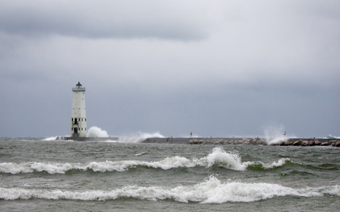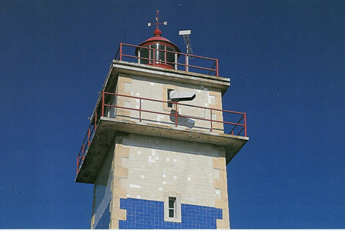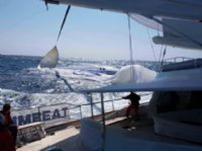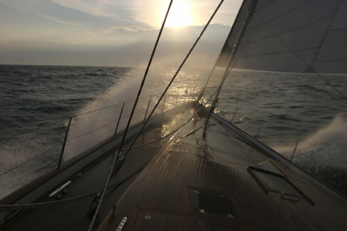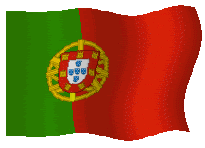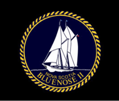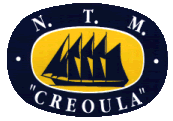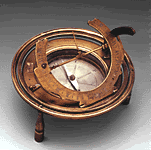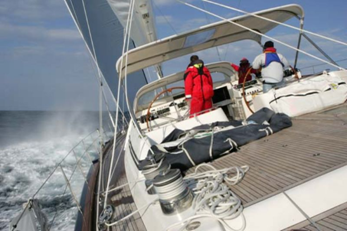
This morning, in thick English Channel fog, Robert Miller's (Hong Kong/New York, N.Y.) 140-foot (43m) Mari-Cha IV passed through the four-mile-long gate off the Lizard on the Rolex Transatlantic Race to break the 100-year-old record set by Charlie Barr on board Wilson Marshall's 185-foot (56.4m) Atlantic.
Miller's giant state-of-the-art racing schooner completed the 2,925-nautical mile passage, east across the North Atlantic between New York and the Lizard, in a time of 9 days, 15 hours, 55 minutes and 23 seconds-a full 2 days, 12 hours, 6 minutes and 56 seconds faster than Atlantic's record-breaking voyage 100 years ago.
“It is a great feat,” commented Mari-Cha IV's owner Robert Miller. “For a record to stand 100 years, and we've had the honour to make an attempt and be successful at it--I am over the moon, overjoyed. It is fantastic.
This was a very tough trip. We had six days of weather on the nose. We crossed the Gulf Stream, saw some very rough seas there and again headwinds and steep short seas on the nose, and the boat and the crew took a lot of beating.” At one point, pushing the boat beyond its limits ultimately resulted in the mainsail headboard and the headboard cars on both mainsail and mizzen breaking, and the chance of breaking the race record was in jeopardy.
“If the ship or the crew were in danger then we would have had to retire, but we did a very good damage control assessment and the question of retirement was never an option,” continued Miller. “We have a very versatile crew, and we can be really self-contained here, so any type of problem we have been able to overcome this time. We were very fortunate and it all worked out well for us, I'm very happy to say.” In October, 2003, Mari-Cha IV set a monohull passage record between New York and the Lizard of 6 days, 17 hours, 52 minutes and 39 seconds, but for that voyage, in stark contrast to the Rolex Transatlantic Challenge, she had the major advantage of being able to set sail when her crew chose, in optimum weather conditions. In 2005, their voyage was very different.
“Pretty much for the first 1,500 miles we were battling away against everything…the elements, Maximus…and we've still got a big battle on our hands now,” recounted racing helmsman Mike Sanderson (referring to the race finish at the Needles still ahead). “From a record standpoint it is very exciting, especially it being such an old record. It is not every day you break a 100-year-old record. It is incredible that a record like that stood for so long and it was the outright record for so long, too.
So obviously it was an incredible achievement back then, and they've made us fight for it this time as well.” On the approach to the Lizard, Mari-Cha IV passed between Land's End and the Scilly Isles, while 40 miles astern, Charles Brown and Bill Buckley's New Zealand entry Maximus passed outside of the Scillies. Off the Lizard, they became engulfed in thick fog that reduced visibility to just 330 feet (100m).
“We can see the bow of the boat, so it's not true English fog, and we are VMG running down the Channel in 14 knots of wind doing 15.5 knots,” continued Sanderson. Despite their lead, there is still a small possibility of Maximus hunting them down. “We are very concerned about the breeze shutting down, and if that happens they'll bring it up from behind, so we have realised we have a race on our hands still,” said Sanderson.
Fortunately, at present, the tides are relatively weak, removing a potential tactical advantage for the Kiwi maxi. Maximus passed the Lizard at 13:18:55UTC, 3 hours 13 minutes and 32 seconds after Mari-Cha IV. “We are just tootling along doing about 15-6 knots VMG downwind,” commented her veteran navigator Mike Quilter.
We don't have no longer have any wind gear, so I can't tell you how much wind there is.” Like Mari-Cha IV, she was gybing downwind, trying to make the most of the available tide. In Performance Cruising class 1, Chris Gongriepe's schooner Windrose continues to lead the 178-foot (54.3m) Tiara, while Tiara's sistership Drumbeat is ahead on handicap. In the smaller Performance Cruising class 2, John “Hap” Fauth continues to lead on the water in his 116-foot (35.4m) Whisper, while Bugs Baer and William Hubbard III's Tempest is still first on handicap.
As Mari-Cha IV and Maximus reached the Lizard, A. Robert Towbin's Sumurun, the on-the-water and handicap leader in the Classic division, still had 1,653 miles left to go to the Lizard. “We are the back of the pack, and it is pretty discouraging when you hear that the first boat has finished and you still have halfway to go,” admitted Armin Fischer, skipper of Sumurun. “We are about 170 miles ahead of the other two boats, but that can change very rapidly if you hit a weather system in the wrong way.”
At present, Sumurun is waiting for the arrival of the next depression. “We are heading northeast now into the next low, and we will see what happens then. The cards can be dealt differently then. It depends upon how we position ourselves in it.”
To date, their progress has been relatively slow, as unlike the faster boats, Sumurun has been unable to position herself within weather systems to make the best use of the conditions, says Fischer. “We had a lot of horrible light airs and big swells. We had a few good runs. Our best run so far was 256 miles, but that was only one day.”
The boat is generally in good shape except that, like Maximus, they have had electronics issues and have no wind instruments. “It is like learning to sail all over out here without having the instruments, with the woolly ties on the shrouds, etc” said Fischer.
Owner A. Robert Towbin turned 70 on 26 May, but his birthday had to be delayed by 24 hours due to the bad weather. 100 years ago on day 11 of the race for the Kaiser's Cup, Frederick Hoyt on board Atlantic wrote: “Last night was beautiful and clear, but it blew a whole gale throughout, and on coming on deck at 07.30 this morning the ship was running with the wind on the quarter, before the heaviest sea we have yet had.
The wind has been building to the southward gradually since midnight and with no abatement. The squaresail yard was braced pretty well forward, and when she would luff on the crest of a sea it would bury her so at 11 it was taken in and the jib set. A great improvement in her behaviour at once followed, the excessive rolling stopped and she went along drier and apparently faster than before.”
Listen to Robert Miller on MARI-CHA IV via satellite telephone after breaking the transatlantic racing record: www.regattanews.com
...
...
Key Partners Marketing Services (KPMS)
2, Rue des Terreaux,
CH-2000
Neuchâtel, Switzerland
